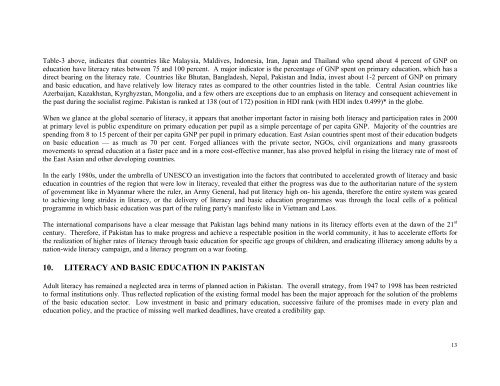Literacy Trends in Pakistan - UNESCO Islamabad
Literacy Trends in Pakistan - UNESCO Islamabad
Literacy Trends in Pakistan - UNESCO Islamabad
Create successful ePaper yourself
Turn your PDF publications into a flip-book with our unique Google optimized e-Paper software.
Table-3 above, <strong>in</strong>dicates that countries like Malaysia, Maldives, Indonesia, Iran, Japan and Thailand who spend about 4 percent of GNP oneducation have literacy rates between 75 and 100 percent. A major <strong>in</strong>dicator is the percentage of GNP spent on primary education, which has adirect bear<strong>in</strong>g on the literacy rate. Countries like Bhutan, Bangladesh, Nepal, <strong>Pakistan</strong> and India, <strong>in</strong>vest about 1-2 percent of GNP on primaryand basic education, and have relatively low literacy rates as compared to the other countries listed <strong>in</strong> the table. Central Asian countries likeAzerbaijan, Kazakhstan, Kyrghyzstan, Mongolia, and a few others are exceptions due to an emphasis on literacy and consequent achievement <strong>in</strong>the past dur<strong>in</strong>g the socialist regime. <strong>Pakistan</strong> is ranked at 138 (out of 172) position <strong>in</strong> HDI rank (with HDI <strong>in</strong>dex 0.499)* <strong>in</strong> the globe.When we glance at the global scenario of literacy, it appears that another important factor <strong>in</strong> rais<strong>in</strong>g both literacy and participation rates <strong>in</strong> 2000at primary level is public expenditure on primary education per pupil as a simple percentage of per capita GNP. Majority of the countries arespend<strong>in</strong>g from 8 to 15 percent of their per capita GNP per pupil <strong>in</strong> primary education. East Asian countries spent most of their education budgetson basic education — as much as 70 per cent. Forged alliances with the private sector, NGOs, civil organizations and many grassrootsmovements to spread education at a faster pace and <strong>in</strong> a more cost-effective manner, has also proved helpful <strong>in</strong> ris<strong>in</strong>g the literacy rate of most ofthe East Asian and other develop<strong>in</strong>g countries.In the early 1980s, under the umbrella of <strong>UNESCO</strong> an <strong>in</strong>vestigation <strong>in</strong>to the factors that contributed to accelerated growth of literacy and basiceducation <strong>in</strong> countries of the region that were low <strong>in</strong> literacy, revealed that either the progress was due to the authoritarian nature of the systemof government like <strong>in</strong> Myanmar where the ruler, an Army General, had put literacy high on- his agenda, therefore the entire system was gearedto achiev<strong>in</strong>g long strides <strong>in</strong> literacy, or the delivery of literacy and basic education programmes was through the local cells of a politicalprogramme <strong>in</strong> which basic education was part of the rul<strong>in</strong>g party's manifesto like <strong>in</strong> Vietnam and Laos.The <strong>in</strong>ternational comparisons have a clear message that <strong>Pakistan</strong> lags beh<strong>in</strong>d many nations <strong>in</strong> its literacy efforts even at the dawn of the 21 stcentury. Therefore, if <strong>Pakistan</strong> has to make progress and achieve a respectable position <strong>in</strong> the world community, it has to accelerate efforts forthe realization of higher rates of literacy through basic education for specific age groups of children, and eradicat<strong>in</strong>g illiteracy among adults by anation-wide literacy campaign, and a literacy program on a war foot<strong>in</strong>g.10. LITERACY AND BASIC EDUCATION IN PAKISTANAdult literacy has rema<strong>in</strong>ed a neglected area <strong>in</strong> terms of planned action <strong>in</strong> <strong>Pakistan</strong>. The overall strategy, from 1947 to 1998 has been restrictedto formal <strong>in</strong>stitutions only. Thus reflected replication of the exist<strong>in</strong>g formal model has been the major approach for the solution of the problemsof the basic education sector. Low <strong>in</strong>vestment <strong>in</strong> basic and primary education, successive failure of the promises made <strong>in</strong> every plan andeducation policy, and the practice of miss<strong>in</strong>g well marked deadl<strong>in</strong>es, have created a credibility gap.13
















